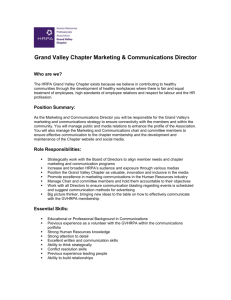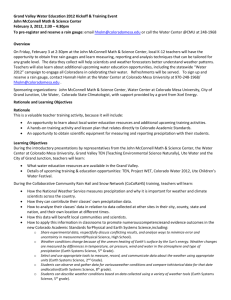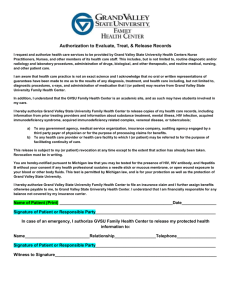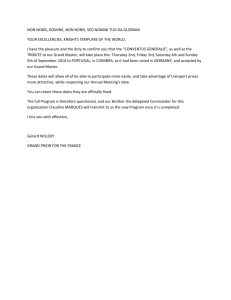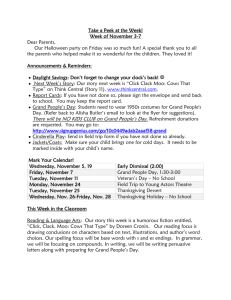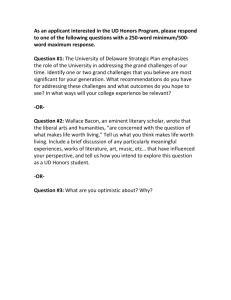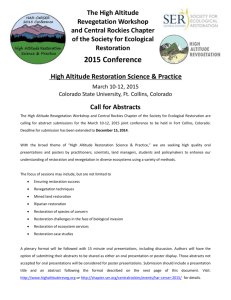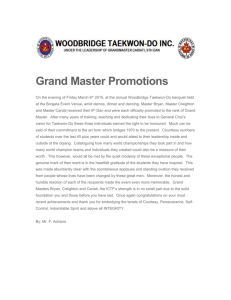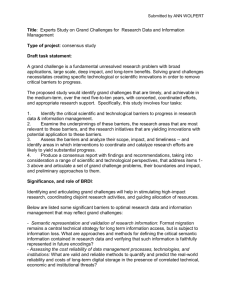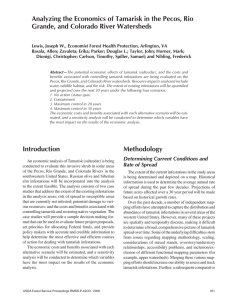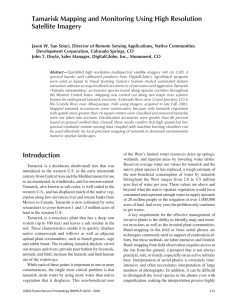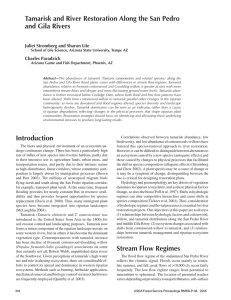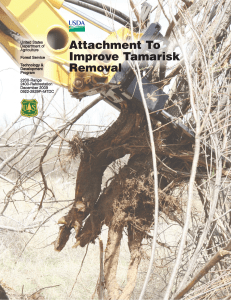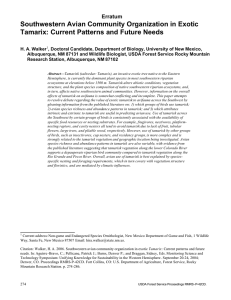Notes - Tamarisk Coalition
advertisement
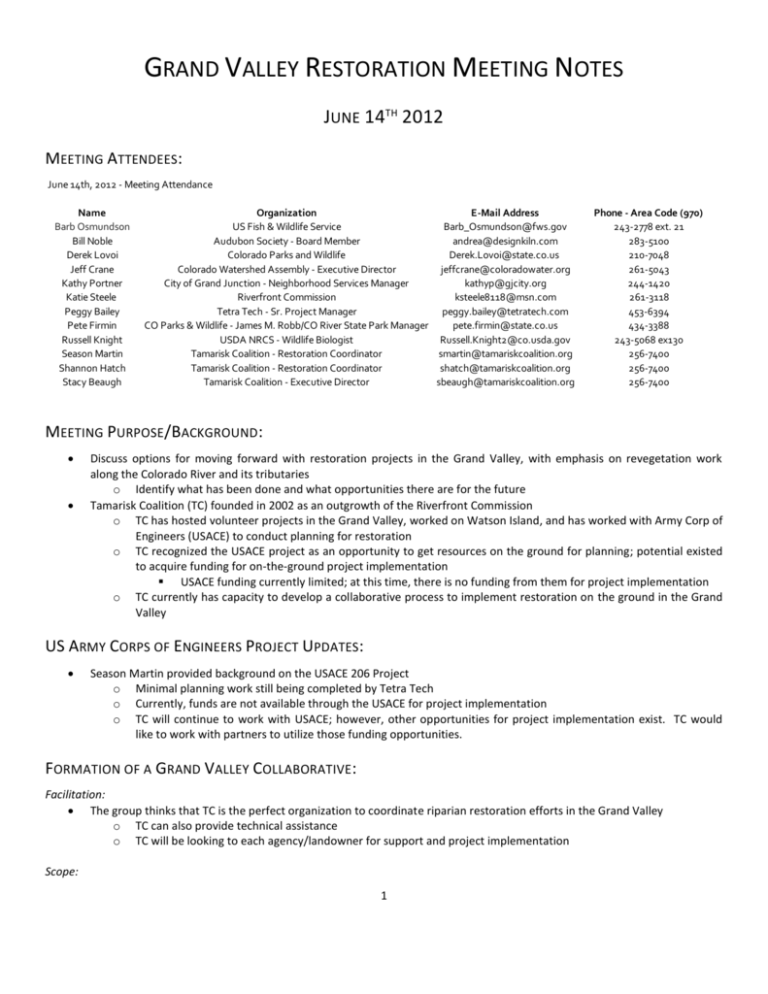
GRAND VALLEY RESTORATION MEETING NOTES JUNE 14TH 2012 MEETING ATTENDEES: June 14th, 2012 - Meeting Attendance Name Barb Osmundson Bill Noble Derek Lovoi Jeff Crane Kathy Portner Katie Steele Peggy Bailey Pete Firmin Russell Knight Season Martin Shannon Hatch Stacy Beaugh Organization E-Mail Address US Fish & Wildlife Service Barb_Osmundson@fws.gov Audubon Society - Board Member andrea@designkiln.com Colorado Parks and Wildlife Derek.Lovoi@state.co.us Colorado Watershed Assembly - Executive Director jeffcrane@coloradowater.org City of Grand Junction - Neighborhood Services Manager kathyp@gjcity.org Riverfront Commission ksteele8118@msn.com Tetra Tech - Sr. Project Manager peggy.bailey@tetratech.com CO Parks & Wildlife - James M. Robb/CO River State Park Manager pete.firmin@state.co.us USDA NRCS - Wildlife Biologist Russell.Knight2@co.usda.gov Tamarisk Coalition - Restoration Coordinator smartin@tamariskcoalition.org Tamarisk Coalition - Restoration Coordinator shatch@tamariskcoalition.org Tamarisk Coalition - Executive Director sbeaugh@tamariskcoalition.org Phone - Area Code (970) 243-2778 ext. 21 283-5100 210-7048 261-5043 244-1420 261-3118 453-6394 434-3388 243-5068 ex130 256-7400 256-7400 256-7400 MEETING PURPOSE/BACKGROUND: Discuss options for moving forward with restoration projects in the Grand Valley, with emphasis on revegetation work along the Colorado River and its tributaries o Identify what has been done and what opportunities there are for the future Tamarisk Coalition (TC) founded in 2002 as an outgrowth of the Riverfront Commission o TC has hosted volunteer projects in the Grand Valley, worked on Watson Island, and has worked with Army Corp of Engineers (USACE) to conduct planning for restoration o TC recognized the USACE project as an opportunity to get resources on the ground for planning; potential existed to acquire funding for on-the-ground project implementation USACE funding currently limited; at this time, there is no funding from them for project implementation o TC currently has capacity to develop a collaborative process to implement restoration on the ground in the Grand Valley US ARMY CORPS OF ENGINEERS PROJECT UPDATES: Season Martin provided background on the USACE 206 Project o Minimal planning work still being completed by Tetra Tech o Currently, funds are not available through the USACE for project implementation o TC will continue to work with USACE; however, other opportunities for project implementation exist. TC would like to work with partners to utilize those funding opportunities. FORMATION OF A GRAND VALLEY COLLABORATIVE: Facilitation: The group thinks that TC is the perfect organization to coordinate riparian restoration efforts in the Grand Valley o TC can also provide technical assistance o TC will be looking to each agency/landowner for support and project implementation Scope: 1 Additional discussions need to be held to define the scope of this initiative; add to agenda for next meeting o Some suggested a smaller project footprint Many have limited staff/funding to complete additional projects o Others suggested a larger focus, however, project prioritization was advocated Sites located in the public eye could help garner support from residents Water quality enhancement through invasives removal could attract 319 program funds; work on the development of wetlands and riparian buffers May want to focus on selenium and salinity o Salinity Control Program funding may be an option Bank stabilization also of concern o Expansion of the project footprint to Colorado River tributaries could assist private landowners NRCS funds are more applicable to lands located off of the river corridor Cooperative Watershed Management Program (lead by US Bureau of Reclamation) is pushing the development of watershed partnership groups; funding opportunities should be available in the future (grant period open now). Other groups/people to include? o Homeless Coalition; Katie Steele will think about an appropriate contact o United Gravel o Zane McCallister at Grand River Mosquito Control District Very ecosystem conscious; would be great to include to coordinate efforts to benefit the tamarisk leaf beetle Private landowners along the river could work through NRCS, Mesa Land Trust o Work on the Dolores River could serve as a model for private landowner engagement Landowners are responsible for their own land but through an MOU, landowners share a common vision and similar goals Riverfront Commission planning/implementation could also serve as a model for how work can be prioritized and completed IDENTIFICATION OF GRAND VALLEY PROJECTS FOR COLORADO BASIN ROUNDTABLE (CBRT) FUNDING: Background: Other funding opportunities are available, however, focus in currently on the CBRT grant as it is due June 18th, 2012 CBRT can fund TC capacity and implementation on the ground. Projects must also meet requirements laid out in Colorado Water Conservation Board (CWCB) Tamarisk and Russian Olive (TRO) grant program TC can’t apply fom TRO grant program, but we can work with landowners to determine eligibility 15% match needed; can be counted back to Dec 2011. There are no restrictions on match source. Project monitoring and maintenance are required grant components. Project Selection for Funding: Many partners suggested that it would be helpful to have a list of priority projects to select from; want to avoid piecemeal approach o ACOE Report could be a starting point o One meeting attendee suggested dividing the river into sections and then creating a table with potential projects, treatments, funding sources, and partners Partners stressed the need for monitoring and maintenance funding o Partners want to avoid problems encountered in the past (e.g. tamarisk re-growth after removal due to limited maintenance funding) Willing landowner(s) is/are key consideration Specific Project Ideas/Needs: After discussion, the group selected top priorities to be considered for funding through the current CBRT granting process. These projects are bolded. Cottonwood fencing from beaver predation at Audubon’s Ela Property Riverbend Park in Palisade – revegetation and bank stabilization work 2 Jarvis Island and associated pond (5th Street Bridge Complex) – invasives control and revegetation Connected Lakes State Park - invasives control and revegetation Redlands Parkway sites (City of Grand Junction and Mesa County sites) Watson Island revegetation Walter Walker backwater habitat creation Private landowners in Palisade have expressed a desire to conduct work on their land Secondary weed control is a need at several locations Plant materials development Project coordination support Concerns: Colorado Parks and Wildlife is concerned about implementing the projects they are working on under the Basin States Parallel Program; have limited staff to take on additional work o Currently not in Walter Walker backwater creation project; can revisit as later date Baseline data collection should be a consideration prior to project implementation FOLLOW-UP & NEXT MEETING CONSIDERATIONS: TC will complete CBRT grant. Projects that were bolded above will be described in the grant o TC will work with partners to complete application, including match contribution information o Completed application will be send to partners for review Next meeting tentatively set for July 18, 2012 from 9-12 o Topics to include: Project scope and partner responsibilities MOU development Short –and long-term project prioritization for additional grant funding If available, bring management plans that may help to guide discussion Plant materials development Permitting needs 3
